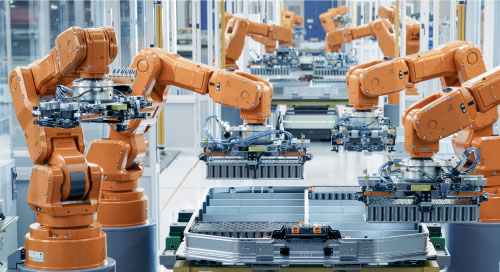Fill form to unlock content
Error - something went wrong!
Your content is just a step away. Please submit below.
Thank you!
Enabling Industrial Automation at the Edge

Industrial applications are growing more sophisticated, thanks to recent advancements in artificial intelligence. “Since the rise of ChatGPT, we’ve seen more and more use cases reliant on generative AI—from autonomous robots and augmented reality to smart cameras,” explains Steven Shi, Senior Product Sales Manager of Boards at AAEON, a leading provider of intelligent IoT solutions.
But increased reliance on AI comes with its own set of challenges. For starters, AI-powered solutions deployed for real-time operations must perform across multiple systems with tight latencies that the cloud is not equipped to handle. As a result, more and more data processing is shifting to the edge.
But existing edge hardware can’t provide performance and throughput necessary for industrial AI automation operations—requiring organizations to adopt new edge hardware.
Anatomy of Industrial Edge-First Hardware Design
To meet the demands of today’s industrial applications, industrial edge systems must deliver exceptional performance in a small form factor, operate in harsh environments with low power consumption, and support Time-Sensitive Networking (TSN).
TSN is an industry standard that enables deterministic communication over Ethernet networks, enabling precise real-time coordination among far-flung systems. This is especially important in industrial automation environments where accurate timing is crucial.
To meet the demands of today’s industrial applications, industrial #edge systems must deliver exceptional performance in a small form factor, operate in harsh environments with low power consumption, and support TSN. @AAEON via @insightdottech
Thankfully, companies like AAEON that specialize in hardware for industrial automation have many years of experience delivering high-performance capabilities alongside efficiency and thermal robustness. AAEON’s COM-RAPC6 and NanoCOM-RAP computer-on-modules, for example, keep with this trend.
“Because we’re talking about the edge, sometimes space is also a challenge,” Shi explains. “That’s why AAEON put so much focus on compact designs like the COM Express Mini.”
Designed according to the COM Express standard, both systems feature a compact form factor with considerable power efficiency. NanoCOM-RAP also provide wide voltage input, allowing them to manage power fluctuations more effectively.
Each module also features the 13th Gen Intel® Core™ processor. Built to deliver energy-efficient, optimal performance for edge use cases, these processors feature flexible hybrid architecture with support for hardware-enabled AI acceleration, multitasking, and concurrent workloads.
AAEON has also designed both of its modules for rugged environments and tested them through a unique process known as Wide Temperature Assurance Service (WiTAS).
“As with some AAEON boards and modules, COM-RAPC6 and NanoCOM-RAP are WiTAS qualified,” says Shi. “We have put them through a very strict quality control process to guarantee they can operate in a temperature range from –40°C to 85°C.”
The COM-RAPC6 and NanoCOM-RAP offer 2.5 Gigabit Ethernet, enabling support for TSN. Both COM-RAPC6 and NanoCOM-RAP include a discrete TPM for additional security. Additionally, they are equipped with high-speed PCIe interfaces with support for PCIe expansion through a carrier board. This allows for scaling AI performance by accommodating add-ons like AI accelerator cards via PCIe interface on the carrier board.
AAEON also offers Q-Service, a technical service program in which it leverages its engineering expertise to help clients bring products to market much faster. This includes assisting with both design and debugging, as well as providing software support and BIOS customization. Last, the company provides a user-friendly interface for UI development and device monitoring in AAEON Hi-Safe.
Building a Smarter Industrial Edge
AAEON is already creating a new product line that will take advantage of the 14th Gen Intel® Core™ Ultra processors and provide many more benefits to embedded and industrial manufacturers. The 14th Gen processors deliver even better power efficiency than their predecessors and include both advanced GPU and an embedded Neural Processing Unit (NPU) for AI acceleration as well as support for high-speed WiFi 6E.
“Systems built around these processors will be able to better handle the environmental challenges and resource requirements at the edge. I strongly believe that this will open new opportunities and possibilities for what edge hardware can achieve,” says Shi.
According to David Huang, Product Manager at AAEON, the most significant feature of the new processors is the embedded NPU. “Moving forward, I think AI-enabled hardware will eventually be as ubiquitous as cell phones or calculators. The embedded Wi-Fi 6E capability will also be very beneficial for our designs over the next three to five years,” he explains.
Looking Toward the Future of Industrial Automation
In the future, AAEON expects that demand for edge AI will only continue to grow. Hardware that features on-board AI acceleration will become increasingly important amid mounting data processing requirements. AAEON, for its part, is more than ready.
“We foresaw that IoT was coming, and that there would be an age after that defined by artificial intelligence,” explains Huang. “In light of that, starting from 2016, our focus has been on creating high-performance embedded products with a small form factor. By doing this, we’ve enabled our customers to perform the necessary edge processing to support applications such as computer vision and autonomous mobile robots—and we plan to continue down this road.”
For industrial organizations looking to solve the challenges of AI-driven edge automation, COM Express module such as the COM-RAPC6 and NanoCOM-RAP provide the necessary performance, power efficiency, and network throughput. Deploying such hardware with assistance from vendors like AAEON can help businesses ensure they’re ready to make the most of what AI has to offer, both now and in the future.
This article was edited by Christina Cardoza, Editorial Director for insight.tech.